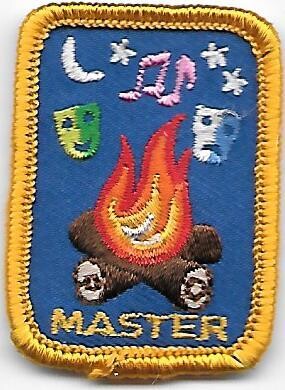Master of the Campfire Chesapeake Bay Council own IP (Original)
Requirements:
Master of the Campfire The Master of the Campfire IP is an interest project from the Girl Scouts of the Chesapeake Bay Council and from the Girls Scouts of Central Maryland.
Skill Builders
1. Learn the elements of a good campfire program. Know how to do the following:
2. Create your own campfire notebook to be used as a resource. Include stories, songs & skits. Be sure your campfire book has a cover, a title page, table of contents, section title pages & a resource list.
3. Learn songs to fit the different parts of a campfire program: opening, action, participation, reflective and inspirational and closing. If possible, attend a song workshop. Learn how to teach songs to a group of people. Learn how to direct a round. Teach your troop or another group a song or round.
4. Learn how to present skits, runons and cheers. Learn some in each category, practice them, then present them at a troop meeting or at a campfire.
5. Story telling is an ancient art. Learn about good story telling techniques. Learn several stories from the following categories: fables, fairy tales, folk tales, myths, stories from other cultures, and audience participation stories. Choose at least one story and learn it well enough to tell with ease. Present your story to an audience using good story telling techniques.
6. Create your own skit or story or song. Write it down, practice it and perform it at a campfire.
Technology
1. Develop your own multimedia resource list of books & other already prepared materials that could be used in planning a campfire. Go to your local library, bookstore, video store, school library, community or troop resources. Where possible, find resources available on the World Wide Web. Tapes and videos may also be available.
2. Learn how to build a ceremonial campfire and ways to light it as if by magic. Then at a troop or multitroop event, build and light a fire for a campfire program or ceremony.
3. You’ve just planned a terrific campfire program but then the rains come! Build an artificial fire that can be used indoors or in an area outdoors that doesn’t allow open fires. Strips of colored tissue paper or colored cellophane can be used to simulate flames. A battery powered fan or twinkling Christmas tree lights can be used to simulate flickering. Think of at least one other way to created the illusion of flames or movement. Remember, it’s the “fire” that makes a campfire special.
4. Find out more about the physical aspects of putting on a performance. Learn about sound effects such as thunder, special effects such as a steaming cauldron, and how to use props effectively. Try “Paper Bag Dramatics”. Working in at least two groups, gather at least six objects and put them in a paper bag. Then exchange bags. Give each group time to make up a story using the contents of their bag as props. Then have each group present their story.
Service Projects
1. Using the elements of a good campfire program, plan and take part in a campfire for an encampment. Take part in putting on the program by doing at least one of the following: Master of the Campfire, lead or teach a song, direct and perform in a skit, tell a story or lead an audience participation story.
2. Using the elements of a good campfire program plan and take part in a campfire for a younger group. Take part in putting on the program by doing at least one of the following: Master of the Campfire, lead or teach a song, direct and perform in a skit, tell a story or lead an audience participation story.
3. Using the elements of a good campfire program plan and take part in a campfire for a multitroop event. Take part in putting on the program by doing at least one of the following: Master of the Campfire, lead or teach a song, direct and perform in a skit, tell a story or lead an audience participation story.
Career Exploration
1. With the increasing popularity of the outdoor classroom, explore career possibilities in recreation, ecology, education and outdoor adventure. Learn about jobs in the outdoors such as camp counselor, camp director, camp administrator, program specialist, site manager, and others.
2. Learn about career possibilities in our local, state and national parks.
3. List the careers that you are interested in pursuing and identify leadership skills that you will need to succeed in those fields. Review the leadership skills you learned working on this interest project. These might include consensus building, organizational skills, public speaking, presentation sills, showmanship, etc.
4. What do teachers and performers have in common? List some of the performance techniques you have learned while working on this interest project. Then, talk with at least two teachers and find out if and how they use performance techniques in the course of their work. Find out if they use songs, drama, storytelling or audience participation to keep interest levels high and to reinforce learning.
.
